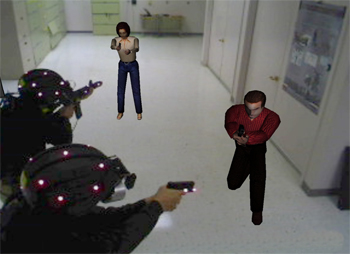
Sandia National Laboratories has developed a state-of-the-art AR training system that is based on Umbra and allows live players to be immersed within a simulation or visualization. As an extreme example of LVC, users and objects in the AR space can be imported into the simulation while the simulation can control objects in the AR space. Users can wear heads-up displays to have full AR experience, or simply manipulate objects in real space that are tracked and co-simulated within computers.
One example of full AR use is a close-quarters combat simulation. This system uses a wearable AR system to place the user in a real environment while engaging enemy combatants in virtual. The enabling technology uses a set of linear optical sensors to track LEDs that are mounted to the helmet and weapon to achieve excellent accuracy and update rates. Users experience intelligent automatic behaviors of the simulated virtual humans (such as crawling on the real floor with good apparent registration), leading to a real sense of their presence. Enemy characters can come from behind virtual walls, doors, and other fixed occluding obstacles. Participants can engage and interact with them.
Another example of AR use allows manipulation of live objects that represent dangerous assets. To provide a training environment for users, object systems and physics are simulated along with other tools and sensors and projected back into the AR space. This approach allows training without the burden of dangerous objects and allows sensitive information to be kept on computer hard disks.